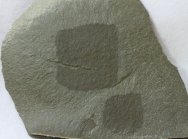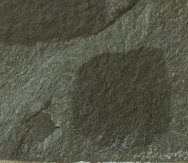Salpidae
indet
Phylum
Chordata, Subphylum Tunicata, Class Thaliacea, Order Salpida, Family Salpidae
Geological
Time: Mississippian (~320 m.y.a.)
Size (25.4
mm = 1 inch): 23 mm long by 31 mm across – 40 mm long by 34 mm
across Matrix: 100 mm by 90 mm
Fossil Site:
Heath Shale Formation, Bear Gulch Limestone, Fergus County, Montana
Fossil Code:
BGF586
Price: Sold
 Description:
The Bear Gulch Limestone is a deposit of some 70 square km in
extent and 30 m in depth that has been a source of one of the
most diverse assemblages of fossil fish with some 110 species
having been described over the past 30 years. Most were new to
science, and provided a unique view of the marine environment
of Mississippian times. Fine preservation of both fish and invertebrates
is a hallmark of these deposits, presumably due to an anoxic
depositional environment. Description:
The Bear Gulch Limestone is a deposit of some 70 square km in
extent and 30 m in depth that has been a source of one of the
most diverse assemblages of fossil fish with some 110 species
having been described over the past 30 years. Most were new to
science, and provided a unique view of the marine environment
of Mississippian times. Fine preservation of both fish and invertebrates
is a hallmark of these deposits, presumably due to an anoxic
depositional environment.
These
specimens are known salps, a planktonic tunicate that moves through
the water column by pumping
water through its gelatinous body. This pumped water is strained
for the phytoplankton contained. While salps appear morphologically
similar to jellyfish, they are actually most closely related
to the vertebrates. Their rudimentary nervous system is thought
to have been the precursor to the more complex one in vertebrates
of today. |
|



